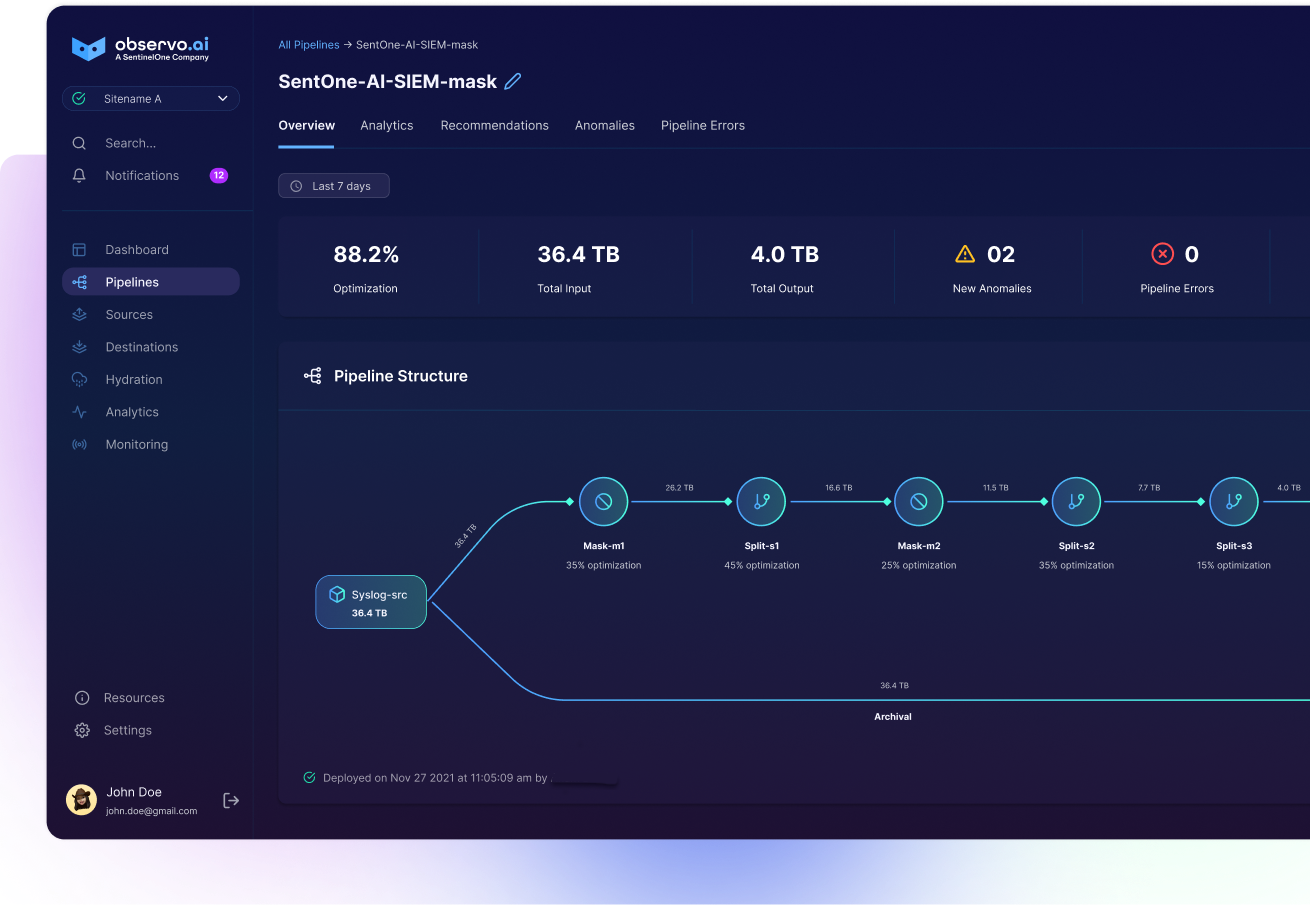Observability 101: What is Telemetry?

Key Takeaways
- Core Components of Telemetry: Telemetry encompasses data sources, collection processes, transmission methods, and analysis. This system allows for real-time monitoring and decision-making, using advanced techniques like machine learning and data visualization.
- Wide-Ranging Applications: Telemetry is vital across various industries for functions like security detection, application performance monitoring, and the Internet of Things, where it enables enhanced performance and proactive issue resolution.
- Technological Advancements and Integration: The blog highlights the integration of cutting-edge technologies, including AI and edge computing, which streamline and enhance telemetry processes. OpenTelemetry (OTEL) is noted for its role in standardizing telemetry data collection and processing, ensuring compatibility and comprehensive system management.
What is Telemetry?
Telemetry is the dynamic process of collecting, measuring, and relaying software usage and user data from remote sources to a central hub for analysis. This crucial data helps enhance monitoring, control, and optimization of remote systems, ensuring they operate at peak performance. As a specialized branch of system monitoring, telemetry integrates advanced sensors and analytics to provide real-time insights and ensure everything runs smoothly.
Introduction
In the ever-evolving landscape of technology, telemetry stands as a silent but powerful force, enabling organizations to gather and analyze data remotely. Derived from the Greek words "tele" (remote) and "metron" (measure), telemetry involves the collection and transmission of data from remote sources to a central location for monitoring, analysis, and decision-making. In today's data-driven world, organizations are constantly seeking ways to gather actionable insights to improve performance, optimize operations, and enhance security measures. Telemetry, a rapidly evolving technology, has emerged as a crucial tool in achieving these objectives. In this blog, we will explore the concept of telemetry, discuss its basic and advanced concepts, explore its applications, highlight the value of telemetry data, dive into technical details, and provide real-world examples of telemetry data. This blog explores the intricacies of telemetry, from its basic concepts to advanced applications, showcasing its value across various industries.
Telemetry begins with the fundamental concept of sensor data collection. Sensors are strategically placed on remote objects, devices, or systems to capture real-time information. This data is then transmitted through wired or wireless communication channels to a central hub or server for processing and analysis. The core components of telemetry include sensors, transmitters, communication channels, and a central processing unit. At its core, telemetry revolves around four fundamental components:
- Data Sources: Sensors, devices, software, and systems that generate data.
- Collection: The process of acquiring data from these sources, often using specialized tools or agents.
- Transmission: The mechanism used to transfer collected data to a central location, usually via networks or communication protocols.
- Analysis: The evaluation and interpretation of collected data to derive insights, identify patterns, or make predictions.
As technology advances, telemetry has evolved to encompass sophisticated concepts and techniques. Machine learning and artificial intelligence play a crucial role in processing vast amounts of telemetry data, extracting meaningful patterns, and providing actionable insights. Additionally, edge computing has emerged to process telemetry data closer to its source, reducing latency and enhancing real-time decision-making capabilities. As organizations embrace telemetry, they often move beyond the basic concepts to explore more advanced techniques. Some of these include:
- Real-time Monitoring: Continuous data collection and analysis in real-time, enabling organizations to respond promptly to critical events or anomalies. Examples include Security event log data such as firewall logs, infrastructure data such as VPC Flow logs, etc.
- Machine Learning (ML): Using ML algorithms to analyze telemetry data, enabling predictive modeling, anomaly detection, and automated decision-making.
- Correlation: Combining telemetry data from multiple sources to identify dependencies and interactions between systems, improve troubleshooting, and enhance overall performance.
- Data Visualization: Transforming telemetry data into visually appealing charts, graphs, or dashboards to aid in data exploration, quick insights, and actionable decision-making.
Telemetry finds applications across a multitude of industries, revolutionizing the way organizations operate and make informed decisions. Some common use cases include:
- Security Detection: Telemetry is instrumental in identifying and responding to security threats. Security information and event management (SIEM) systems leverage telemetry data to detect anomalies, monitor user behavior, and enhance overall cybersecurity.
- Application Performance Monitoring (APM): APM relies on telemetry to gain insights into the performance of software applications. By collecting data on response times, resource utilization, and error rates, organizations can optimize their applications for peak efficiency.
- Log management: Log Management is the centralized collection, storage, analysis, and visualization of log data generated by systems, applications, and services. Log management facilitates the aggregation and correlation of logs, allowing for effective monitoring, troubleshooting, and ensuring the reliability and security of systems within an observability framework.
- Autonomous Vehicles: Telemetry is critical in the development and operation of autonomous vehicles. Sensors collect real-time data on speed, distance, location, and vehicle condition, enabling remote monitoring, predictive maintenance, and improved safety.
- Internet of Things (IoT): The proliferation of IoT devices relies heavily on telemetry for monitoring, managing, and optimizing connected devices, enabling real-time decision-making and automation.
The Value of Telemetry Data
Telemetry data is invaluable for organizations seeking to enhance their operations and performance. It provides real-time visibility into processes, enabling proactive decision-making and rapid response to emerging issues. The benefits of telemetry data include:
- Improved Efficiency: Telemetry helps organizations streamline their processes by identifying inefficiencies and optimizing workflows based on data-driven insights.
- Enhanced Security: The real-time monitoring of telemetry data allows for early detection of security threats, preventing potential breaches and unauthorized access.
- Performance Optimization: By analyzing telemetry data, organizations can identify areas for improvement, optimize resource allocation, and enhance overall system performance.
- Proactive Issue Resolution: Telemetry enables early detection and swift resolution of issues, minimizing downtime, and preventing potential failures.
- Data-driven Insights: Telemetry data provides valuable insights into system behavior, user patterns, and environmental conditions, informing strategic decision-making and enabling innovation.
Technical Details
The technical aspects of telemetry involve the careful selection of sensors, communication protocols, and data processing methodologies. Open standards such as MQTT (Message Queuing Telemetry Transport) and protocols like RESTful APIs are commonly used for transmitting telemetry data. Data encryption and secure communication channels are paramount to ensure the confidentiality and integrity of the transmitted information.
The process of telemetry involves several technical aspects, including:
- Data Collection: Employing agents, monitoring tools, or embedded sensors to capture data from various sources.
- Data Transmission: Utilizing communication protocols such as MQTT, HTTP, or WebSocket to securely transmit telemetry data over the network.
- Data Storage: Choosing appropriate storage solutions like databases or data lakes to store telemetry data securely and efficiently.
- Data Analysis: Employing analytics platforms or frameworks, such as Apache Kafka, Elasticsearch, or Splunk, to process, analyze, and visualize telemetry data.
OpenTelemetry (OTEL) stands out as a significant player in standardizing the collection, processing, and exporting of telemetry data. OTEL, an open-source project, serves as a framework to gather essential metrics, logs, and traces from diverse sources within cloud-native environments. Its role extends beyond mere data transmission, focusing on harmonizing the acquisition of telemetry information for enhanced observability and security measures. OTEL facilitates a standardized approach, ensuring seamless integration and interoperability across various tools and platforms for robust system management. This framework significantly contributes to comprehensive visibility, efficient monitoring, and streamlined security in telemetry data management practices.
Conclusion
Telemetry is a technological marvel that empowers organizations to harness the potential of remote data collection and analysis. From basic sensor data to advanced machine learning applications, telemetry continues to shape the landscape of various industries, offering unprecedented insights and opportunities for innovation. As we delve deeper into the digital age, the role of telemetry in shaping a smarter, more connected world becomes increasingly evident. Learn how an AI-driven Observability pipeline solution, such as Observo.ai, can help optimize telemetry data resulting in cost efficiencies and enhanced security, performance and reliability.




